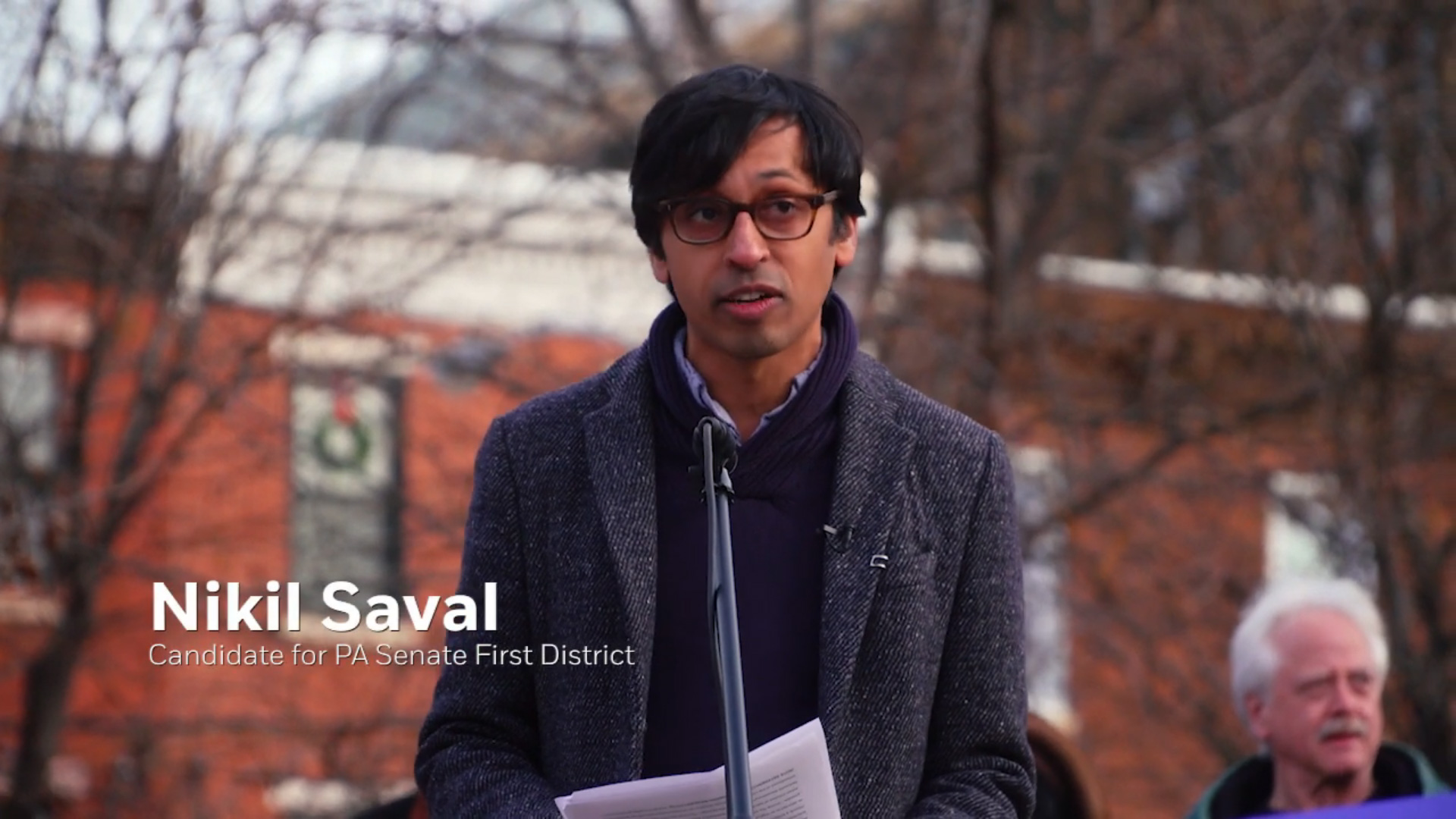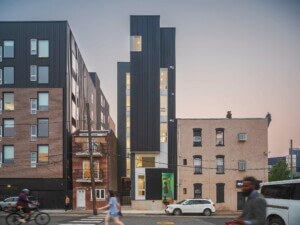In mid-April, the Philadelphia-based writer Nikil Saval was getting a tour of the state capitol in Harrisburg. Months had elapsed since he was elected to represent Pennsylvania’s First Senate District, capping off a socially distanced campaign season. “It was awesome to be there in person,” he said. “It’s a great feeling. We have an office and it’s not my basement.”
Saval is a democratic socialist, with experience in labor organizing. Outside of politics, he has built a profile as a design writer, despite a background in literature. (He was previously the editor of the literary magazine n+1.) It was his 2013 book Cubed: A Secret History of the Workplace that pushed Saval toward architecture and design writing. He spoke to AN executive editor Samuel Medina about his outsider status, the Green New Deal, and why “everything is architecture.”
Samuel Medina: I had just started as an editor at an architecture magazine when Cubed came out. When the review copy arrived at the magazine’s office, it prompted a lot of chatter, much of which revolved around the identity of the author. Did you feel like an interloper when you began researching and writing the book?
Nikil Saval: The answer is yes. [Laughs.] The funny thing is that, even several years after the book came out, I was still being called an “office guru,” which is really bizarre. When I had the impulse to write Cubed, I had no idea how much of a design book it would turn out to be. My initial interest in the history of the office was in the history of office work, and in answering that old question, why are some people called white-collar and others called blue-collar? Why is white-collar office work often seen both by the people who do it and those on the outside as distinct from blue-collar work? And why don’t office workers in the private sector organize unions to the degree that they have historically in the public sector, or as workers in manufacturing and construction have?
That was the initial interest, but then it just became clear that these two things [office work and office design] were intertwined. For example, the history of the word office, in American English usage, is closely tied to the history of the word downtown. The notion is that white-collar neighborhoods and districts and buildings—especially, in the late 19th century and early 20th century, skyscrapers—are part of the separation of what Marx would call mental and manual labor, but what we know as office work and blue-collar work. You start to see a spatial separation. The big spatial constraints—those of cities and buildings and the architectural envelope—led me to the interiors of offices, which were separated and stratified themselves. I started to see how design facilitated and expressed that stratification and differentials in power. So, I couldn’t tell the story of one without telling the story of the other. I was just getting into these different fields. I’m not a historian. I studied literature; I edited a magazine. I had done labor organizing.

So when you stumbled into this world, how were you made to feel?
The thing that makes architecture distinct—really makes you feel it, in a way—is how highly professionalized an industry it is. Historically it’s been skeptical of people who are not trained in the profession, such as critics. And I understand that. I can’t design a building for you. I can’t design an office. I don’t know AutoCAD. In a certain sense, I can’t speak authoritatively about architecture in the way that an architect can. But what I have learned to do over time is speak to someone like me, who is outside the field and interested in it. What was, and is, important to me is speaking to the relationship between work and architecture, between cities and capitalism. That’s always been my interest. To get back to your initial question, I still feel like [an interloper] years after I began writing professionally about architecture.
I wouldn’t feel too bad. I’d wager that the majority of architectural journalists can’t design a building either. [Laughs.] In Cubed, and in some of your work since, you tend to single out the vision of designers over [that of] architects and even give them the benefit of the doubt when their designs inevitably go awry. What accounts for that preference?
I think I was harsher on architects like Le Corbusier when I was writing Cubed than I am now. Perhaps to some degree that was unwarranted. But I always admired the ideas of interior designers and planners, partly because I recognized [in them] an impetus to address a basic discontent with work. Maybe they didn’t identify the sources of this discontent in the way that I or others would, but they nevertheless tried to increase the freedom of office workers overall. People like Robert Propst, the creator of the Action Office, had an interest in a person being able to fashion their own space.
The kinds of freedom designers like Propst were promising are today viewed as shibboleths, at least among a certain set of the workforce. Just think about claims of “self-fulfillment” and “flexibility,” which we’ve heard so much about during the pandemic. From an organizing perspective—and a lot of activity in labor we’re seeing now is happening in the white-collar professions, for good and bad—can these be incorporated into labor messaging and demands?
I tried in Cubed, and am certainly trying to do this more now, to make a connection between the particular kind of freedom designers promised historically to greater forms of freedom. I would also say that there is often too much of a disconnect between design and especially urbanism and the Left. Maybe that’s changing, but we [the Left] should reclaim that language of freedom. Our lives should be better. Any socialist or social democratic worldview should be able to see that an office that is designed from the point of view of a human is good! [Laughs.] You can see this a little bit when you compare Anglo-American offices and those in Northern European countries. Historically, in social democratic economies there were higher degrees of worker participation in design. There were requirements about air and light in offices. That’s not insignificant.
You’re, of course, based in Philadelphia, as was one of the 20th-century office’s major protagonists—or villains—Frederick Winslow Taylor. What’s so grim about Taylor’s methods for time saving, piecework, and surveillance—all hated in their own time—is how they have all been immeasurably enhanced by workplaces like Amazon. That brings me to the recent, failed union drive in Bessemer, Alabama. Do you have any takeaways from that result?
I’m sorry to say this, but I wasn’t surprised and, for that reason, was not overly disappointed by that result. Its potential struck me as overinflated because there were all these warning signs early on that showed it wasn’t going to succeed. Which is not to say that it can’t succeed. I would just say that it’s very difficult to organize a union anywhere, in any workplace. There are very sophisticated tools of union busting that companies employ. Anyone looking at the Bessemer Amazon warehouse and wondering why the union drive failed there should look at their own work. And if they don’t have a union, they should wonder why they don’t.
What Frederick Taylor was trying to do was make organizing a union difficult by creating stratification and competition among blue-collar workers and to create a managerial class, or attitude, towards that work. And that just makes it harder for people to feel solidarity with each other because if you’re trying to compete to do your work better than someone else, or to complete it in a certain time frame, you’re less likely to identify with that person next to you because you’re competing with them. And that was true then and that remains true now.
You won your election in early November. The week prior, Walter Wallace Jr. had just been killed by police, the National Guard had moved in, and you were giving a lecture to architecture students at the Harvard Graduate School of Design [GSD]. That confluence of events—of social unrest, specifically—has typically given architects the impetus, or license, to dream up their most utopian proposals.
That’s a great point. My talk at the GSD was about a visionary, albeit unbuilt plan, for Harlem after the 1964 uprising. But the difference is—and this is apropos of the beginning of our discussion—this was a plan designed by June Jordan, not exactly a trained architect, and Buckminster Fuller, who was also not exactly a trained architect although more integrated into the canon of design, however uneasily. But I would say that my contribution to telling this history is a small one. Really, I’m dependent on the work of Black scholars and designers—for example, the Black Reconstruction Collective. Before I stopped writing for The New Yorker, I was trying to nail down a profile of the artist Amanda Williams; one of her major works is Color(ed) Theory, where she painted abandoned houses in Chicago in reference to redlining.
But in preparing for that GSD talk, I was starting to pick up this history of Black cultural figures participating in the design of public housing projects in the late ’60s. I looked at the Kawaida Towers housing project that Amiri Baraka was helping to spearhead in Newark, New Jersey. That didn’t succeed [at the time], but it was just one example of what was happening at the time. A lot of people are doing work about this period, but there’s still a historical blindness, or myopia, in the profession, as well as a very present, but related, racist exclusion.
Why do you think that is?
Architecture, especially the professional side of architecture, is pretty complicit in practices that prevent us from attending the root causes of exclusion. I think about insecure housing, which overwhelmingly affects Black and Brown and low-income people across the United States. Since the 1960s there’s been a decline in public investments, in housing, in wraparound services for that housing. That’s not to say that architects are uniquely responsible for that decline. Or that they can’t be involved in processes that begin to attend to the root causes of exclusion. Part of it is that these professional societies are not necessarily built for doing that. You need more active, grassroots forms of organization to address exclusion.
On the topic of housing, you recently gave remarks at an event sponsored by the Center for Architecture and UPenn about “green social housing.” That seems a leap from where we currently are. Discussions about housing within architecture and politics rarely go beyond the rubric of “affordability.” How do you communicate, both in your writing and to your constituents, the need to reposition housing as a social good? And do you see a role for architects in repositioning that?
Despite my comments just now about architecture, I know how difficult it can be. We are operating in a difficult framework, in which the amount of subsidies, or just direct government investment in housing, has dramatically declined over decades. And there are all these limits on public housing, what public housing can be constructed, and how many people it serves. But basically, you have to frame housing as a right. But even then, I’m hesitant to speak about it in those terms. We often talk about rights—for example, human rights—only when they are being betrayed. So I would instead say that housing is something that we should be guaranteeing. I’m someone who supports the idea of a Homes Guarantee, which would effectively decommodify housing.
Architects are probably very familiar with the Low-Income Housing Tax Credit [LIHTC] program. That’s the main way that people probably interface with the whole notion of affordable housing. Tax credits are problematic, and the program itself creates a very paltry amount of housing.
You’re never going to build a social good off the back of tax credits.
That’s why one of the things we’re exploring is to what extent we can try to change existing programs like LIHTC to a grant-making program. So if you’re an architect and you’re familiar with LIHTC, it becomes a little more conceivable as to how you can intervene. Because we want to create variety in low-income housing. We want to be able to have big design variability and initiative.
Actually, in Pennsylvania you’re more likely to be awarded credits if you have a Passive House designation or if you have another kind of green initiative. Can we tweak that model by substituting grants for credits? Can we expand it further to include land trusts and other forms of nonprofit development? This actually is not that distinct from how things get built in Vienna, which is one of the premier venues for social housing. It’s something we’re exploring right now and trying to develop some policy papers on it.
You’ve been very public about your support for a Green New Deal. The opinion within the trades is somewhat mixed, and the Biden administration won’t speak its name. Why do you feel it’s a useful framework?
I think the virtue of the Green New Deal is twofold. One is that it anchors our fight against climate change, and the environmental crisis more generally, in investment and in job creation. Historically, I think, people have viewed the environmental movement as a retreat, in a way, from public life and also from a certain quality of life. But we’re saying, no, it’s in our housing, it’s in our transit, it’s in our schools, it’s in the spaces you see and pass through every day. These are all places where we need a Green New Deal. These are all places that we need to protect at once.
And then the second part of that is that our lives are going to be immeasurably better as a result. For example, there are the energy burdens that people face in their homes, to the extent that they are able to stay in their homes. In Philadelphia there’s so much utility debt. Low-income residents have to pay over 23 percent of their income on utilities—that’s not even including rent. Many people have gas lines in their homes and as a result have higher rates of asthma. And low-income homeowners can’t afford to weatherize or retrofit their homes. Your—and I’m speaking from a Philadelphia perspective now—your schools have unremediated lead and exposed asbestos. Your house is making you sick. You can’t get to work without taking five different buses. Why is that the case? We should invest in the things that would make lives better. Those are green initiatives. You would see those changes in daily life. Otherwise, climate change can feel very distant.
You’re currently at work on your next book, Everything Is Architecture. That’s of course a reference to Hans Hollein.
Actually, while it does come from Hollein, my particular reference is to Charles Eames, who redeployed the phrase to say, “Eventually everything connects—people, ideas, objects.” It’s a history about design and how, as soon as it became professionalized, it suddenly was perceived to have to encompass everything. Through industrial design, individual people began interacting with objects, forms of communication, etc., in a more intimate way than they ever did with a building envelope. Anyway, it’s told through a set of figures—so far the Eameses and also Buckminster Fuller—but it’s meant to be a little more global than that American portrait. These are figures who were not quite architects but who expanded the role of design to include aspects of everyday life, and how that had an initial social utopian impulse and then changed over the course of the 20th and 21st centuries.
Fuller talked about a “comprehensive designer” capable of recognizing patterns in media, industry, technology, all these emerging developments in the 1960s. It’s an enticing idea, but also one that’s difficult to envision operating as a social force in the world. Does that get at why you’re interested in outsider figures like him?
That’s a good way of putting it. The notion that design had social potential is something I want to pull out. As I looked into Buckminster Fuller’s archives in California, it was astonishing to see firsthand how many people were creating geodesic domes in the 1960s. And how many people wrote to him to ask for the instructions to how to do one. I want to say thousands of individuals, who were just so animated by this idea of a personal capacity to create shelter from this elemental form of structure and to reimagine their own environments in a context in which people more and more understood the connection between environmental and social crises. I know some of that is well-known, but I thought it was extraordinary. Fuller himself was this polymathic figure who was always on the edge of bullshit to some degree. He really was. [Laughs.] But [the comprehensive designer] is an important form of identification.
Frank Gehry’s renovation of the Philadelphia Museum of Art is set to open in early May. Have you been able to get a peek at the project, and if so, what do you make of it?
When I visited, I was pleasantly surprised by how relatively surgical it was. So far, the main experience is the current entrance, which involves you walking through this tiled hallway under a [Guastavino] tiled ceiling. That wasn’t really revealed before. To the extent that the Gehry project is revealing aspects of the original structure, it’s great. Those parts of it are really good.











